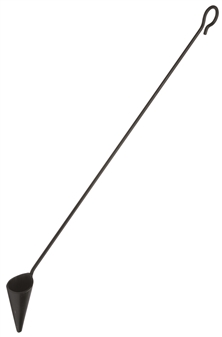One recipe, 2 champions! J.C Algans, roaster extraordinaire, looks after the goose. For the stuffing and the sauce, B. Tenailleau adds some salt and French haute cuisine.
Out of the oven! Goose is a noble meat, but to reveal all its fineness, you must avoid exposing it to temperatures that are too high: take your goose out of the oven and do not heat it too much!
The fatter your goose, the more slowly you will need to start. This may seem illogical, but to reach the right temperature at the heart without burning the surface or drying the meat, the heat has to penetrate it slowly. Place your spit at a safe distance and you will avoid the initial layer of flesh from reaching a temperature that is too high before the inside has had time to cook. By heating it progressively, you avoid the cells drying out and the meat becoming too dry.
Many people think that goose is a fatty meat. On the contrary! Goose, like duck, stores fat to face the winter cold, but the meat is lean. Remember to preserve its water content. Take your time and allow the fat to melt gently to perfume the meat.
Moving on to the practical side Start early. As soon as the goose is in place, baste it with a brush and melted clarified butter, then turn the spit. At first, let it heat up without worrying about the cooking itself. Baste regularly to feed the skin and don´t do anything else. You will soon see how your goose is reacting and you can easily adjust the flame and the distance of the spit. Do not try to get a nice golden skin. Prefer to retain the heat. Remember to maintain the cooking temperature without heating the goose too much.
It will take some time for all the flavours to appear, so don´t rush things. You will easily be able to judge the progress of the cooking. If you are in doubt, use a thermometer. If you are running late, your guests will enjoy the show. And if the goose is cooked, but your guests are not ready, simply move the spit away to keep the goose warm. Once it is off the spit, don´t waste any time!
Allow 3 hours for cooking, but it may take up to an hour more if you take it very slowly.
The heart should not exceed 75° C for the stuffing and for the meat.
When the goose begins to turn brown, start to baste it regularly and at the end of the cooking, flambee the lard using a blower.
The stuffing Depending on the size of your goose, you will need more or less stuffing, but 500 g is a minimum.
Here are the proportions to follow for this amount of sausage meat:
7 whole eggs
40 cl of cream
1 bunch of chopped chive
180 g of finely chopped shallots
7 cl of tawny port
200 g of horn of plenty mushrooms
Salt, pepper.
Mix carefully and if you are unsure about the seasoning, cut a little ball of stuffing in the pan.
When your stuffing is ready, fill the goose and skewer it being careful to keep good balance.
For the sauce: chestnut cream! This sauce is a marvellous accompaniment for goose and is very easy to make. No special technique, no sophisticated devices, simply filter it.
Once the goose and the stuffing are on the plates, cover them with sauce. Nothing could be simpler!
100 g of shallots
80 g of butter
1 small stick of celery
1 kilo of chestnuts
2 litres of milk
Chop the shallots and cut the celery into small cubes.
Over a very gentle flame, leave them to sweat in butter to express their perfume. Don´t let them change colour…
Add your chestnuts and wet them with milk, add salt and leave to cook over a gentle heat.
Once the chestnuts are cooked, mix them in a blender and filter. You can use a fine strainer or a cheesecloth. The texture should be silky enough to reveal all the flavours of the meat.
Bruno Tenailleau is an extraordinary chef. First prize winner of the international dessert prize, he conducts his gastronomic research on a daily basis. Watching him work is very impressive: he composes, he assembles, he plays with textures and contrasts, and works his recipes like a musician or a perfume blender. A real champion! And yet, he is willing to offer us some of his best recipes.
Jean-Claude Algans is not a professional roaster. He began roasting for himself because when he was a child, it was normal practice to cook over the fire. Small pieces for his friends and family, and bigger ones for special occasions or village festivals: he is happy to roast a whole pig, a dozen hams or a large lamb for méchoui. But above all, Jean-Claude explains, he gives away his recipes and demonstrates that spit roasting is for everyone.
We´d like to thank them for his precious advice.





























